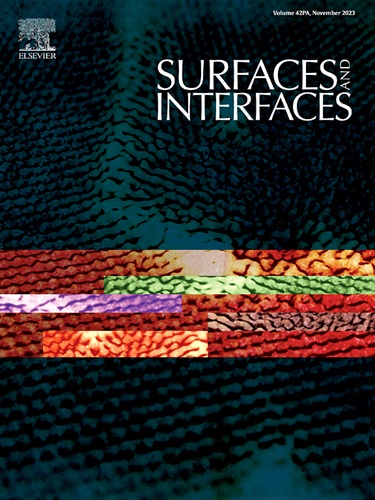Synthesis of Fe2O3-supported lightweight expanded clay aggregate (LECA) via solution combustion: An Innovative and Cost-Effective catalyst for biodiesel generation
IF 5.7
2区 材料科学
Q2 CHEMISTRY, PHYSICAL
引用次数: 0
Abstract
This study investigates the application of ultrasound-assisted Fe2O3 supported on treated lightweight expanded clay aggregate (LECA), synthesized via the solution combustion method, as a catalyst for biodiesel production. The catalyst was characterized using various techniques, including XRD, FESEM, EDX, TEM, BET-BJH, and TPD-NH3. Characterization results indicated that the Fe(0.15)-LECA(U) catalyst exhibited a pore volume of 0.05 cm³/g, a surface area of 22.74 m²/g, and a well-dispersed Fe2O3 on the support surface. TPD-NH3 analysis revealed a significant presence of medium and strong acidic sites, with total acidic site concentrations of 0.736, 2.104, 0.939, and 0.412 mmol NH3/g at temperatures of 214.7, 350.6, 501.3, and 692.4°C, respectively. The high dispersibility of acidic sites increased the rate of reaction as in the condition of 3 wt.% catalyst loading, 95°C reaction temperature, 1-hour reaction time, and a methanol-to-oil molar ratio of 20, the catalyst achieved a remarkable biodiesel conversion of 98.49% with an apparent rate constant of 0.0218. Notably, a 2.02% decrease in conversion was observed after five consecutive reaction cycles, demonstrating the catalyst's excellent stability attributed to the strong bonding between Fe2O3 and treated LECA facilitated by ultrasound treatment.

溶液燃烧法合成fe2o3负载的轻质膨胀粘土骨料(LECA):一种创新且经济高效的生物柴油催化剂
本研究探讨了超声辅助Fe2O3负载于经溶液燃烧法合成的轻质膨胀粘土骨料(LECA)上,作为生物柴油生产催化剂的应用。采用XRD、FESEM、EDX、TEM、BET-BJH、TPD-NH3等技术对催化剂进行了表征。表征结果表明,Fe(0.15)-LECA(U)催化剂的孔体积为0.05 cm³/g,比表面积为22.74 m²/g, Fe2O3在载体表面分散良好。TPD-NH3分析显示,在214.7、350.6、501.3和692.4℃温度下,总酸性位点浓度分别为0.736、2.104、0.939和0.412 mmol NH3/g。酸性位点的高分散性提高了反应速率,在催化剂负载3 wt.%、反应温度95℃、反应时间1 h、甲醇与油的摩尔比为20的条件下,催化剂的生物柴油转化率为98.49%,表观速率常数为0.0218。值得注意的是,在连续5个反应周期后,转化率下降了2.02%,这表明超声波处理促进了Fe2O3与处理过的LECA之间的强结合,从而证明了催化剂的优异稳定性。
本文章由计算机程序翻译,如有差异,请以英文原文为准。
求助全文
约1分钟内获得全文
求助全文
来源期刊

Surfaces and Interfaces
Chemistry-General Chemistry
CiteScore
8.50
自引率
6.50%
发文量
753
审稿时长
35 days
期刊介绍:
The aim of the journal is to provide a respectful outlet for ''sound science'' papers in all research areas on surfaces and interfaces. We define sound science papers as papers that describe new and well-executed research, but that do not necessarily provide brand new insights or are merely a description of research results.
Surfaces and Interfaces publishes research papers in all fields of surface science which may not always find the right home on first submission to our Elsevier sister journals (Applied Surface, Surface and Coatings Technology, Thin Solid Films)
 求助内容:
求助内容: 应助结果提醒方式:
应助结果提醒方式:


